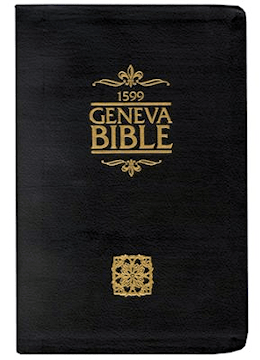Textus Receptus Bibles
Geneva Bible 1560/1599
| 17:1 | There was a man of mount Ephraim, whose name was Michah, |
| 17:2 | And he saide vnto his mother, The eleuen hundreth shekels of siluer that were taken from thee, for the which thou cursedst, and spakedst it, euen in mine hearing, beholde, the siluer is with me, I tooke it. Then his mother saide, Blessed be my sonne of the Lord. |
| 17:3 | And when he had restored the eleuen hundreth shekels of siluer to his mother, his mother sayd, I had dedicate the siluer to the Lord of mine hand for my sonne, to make a grauen and molten image. Now therfore I will giue it thee again. |
| 17:4 | And when he had restored the money vnto his mother, his mother tooke two hundreth shekels of siluer, and gaue them to the founder, which made thereof a grauen and molten image, and it was in the house of Michah. |
| 17:5 | And this man Michah had an house of gods, and made an Ephod, and Teraphim, and cosecrated one of his sonnes, who was his Priest. |
| 17:6 | In those dayes there was no King in Israel, but euery man did that which was good in his owne eyes. |
| 17:7 | There was also a yong man out of Bethlehem Iudah, of the familie of Iudah: who was a Leuite, and soiourned there. |
| 17:8 | And the man departed out of the citie, euen out of Beth-lehem Iudah, to dwell where he coulde finde a place: and as he iourneyed, he came to mount Ephraim to the house of Michah |
| 17:9 | And Michah saide vnto him, Whence comest thou? And the Leuite answered him, I come from Beth-lehem Iudah, and goe to dwell where I may finde a place. |
| 17:10 | Then Michah said vnto him, Dwell with me, and be vnto me a father and a Priest, and I will giue thee ten shekels of siluer by yeere, and a sute of apparell, and thy meate and drinke. So the Leuite went in. |
| 17:11 | And the Leuite was content to dwel with the man, and the yong man was vnto him as one of his owne sonnes. |
| 17:12 | And Michah consecrated the Leuite, and the yong man was his Priest, and was in the house of Michah. |
| 17:13 | Then said Michah, Nowe I know that the Lord will be good vnto me, seeing I haue a Leuite to my Priest. |

Geneva Bible 1560/1599
The Geneva Bible is one of the most influential and historically significant translations of the Bible into English, preceding the King James translation by 51 years. It was the primary Bible of 16th century Protestantism and was the Bible used by William Shakespeare, Oliver Cromwell, John Knox, John Donne, and John Bunyan. The language of the Geneva Bible was more forceful and vigorous and because of this, most readers strongly preferred this version at the time.
The Geneva Bible was produced by a group of English scholars who, fleeing from the reign of Queen Mary, had found refuge in Switzerland. During the reign of Queen Mary, no Bibles were printed in England, the English Bible was no longer used in churches and English Bibles already in churches were removed and burned. Mary was determined to return Britain to Roman Catholicism.
The first English Protestant to die during Mary's turbulent reign was John Rogers in 1555, who had been the editor of the Matthews Bible. At this time, hundreds of Protestants left England and headed for Geneva, a city which under the leadership of Calvin, had become the intellectual and spiritual capital of European Protestants.
One of these exiles was William Whittingham, a fellow of Christ Church at Oxford University, who had been a diplomat, a courtier, was much traveled and skilled in many languages including Greek and Hebrew. He eventually succeeded John Knox as the minister of the English congregation in Geneva. Whittingham went on to publish the 1560 Geneva Bible.
This version is significant because, it came with a variety of scriptural study guides and aids, which included verse citations that allow the reader to cross-reference one verse with numerous relevant verses in the rest of the Bible, introductions to each book of the Bible that acted to summarize all of the material that each book would cover, maps, tables, woodcut illustrations, indices, as well as other included features, all of which would eventually lead to the reputation of the Geneva Bible as history's very first study Bible.